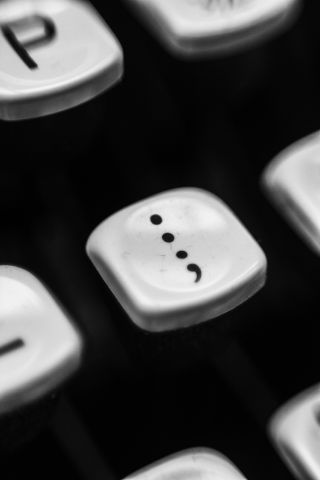Social Life
The Emotional Power Behind Our Punctuation
When did our periods start to sound so angry?
Posted April 14, 2024 Reviewed by Gary Drevitch
Key points
- Punctuation as we know it is a surprisingly recent invention.
- The use of punctuation to grammatically mark a text was not prevalent until well after the Middle Ages.
- Modern texters are re-adopting the rhetorical focus of the ancient Greeks.

If you hang out with anyone under 30, you might have noticed that punctuation has been getting a bad rap lately, especially when it comes to texting. While putting a period at the end of a sentence might be seen as good grammatical form to some, many younger texters increasingly find that its usage comes across as insincere or even angry.
This increasing suspicion of periods joins long-standing arguments over topics like Oxford commas and the proper usage of semi-colons. Clearly, commas, colons, and periods can get people of all ages worked up, so perhaps a look back at punctuation's role in history can give us a little insight into its surprising power.
Ancient marks
It might feel as if punctuation has been around forever, but both punctuation marks and their grammatically informing purpose are surprisingly recent.
In ancient Greece, there was no agreed-upon system of punctuation, and in fact, often very little notation of any kind was used to separate written words or phrases. While some ancient Greek texts used points (i.e., dots) to separate words, it was more common to simply write words one after the other, withnobreaksatall.
Around 200 BCE, Aristophanes, the librarian of Alexandria, devised a point system that was intended to instruct readers on appropriate pause lengths to heighten the rhetorical effect when reading aloud, as was the typical practice when reading texts at the time.
Aristophanes suggested a system of points that should be put in different positions, i.e., after a letter, under a letter, or over a letter, with each positioning indicating how long a pause to take afterward. The labels he gave each of these different pause lengths might sound familiar to modern ears: comma, colon, and periodus. A comma (a point placed at mid position after a letter) indicated the shortest pause, while the periodus (a point placed at the top of the letter) indicated the longest pause.
Though Aristophanes is credited with this first official Western punctuation system, his influence did not go far among his Greek contemporaries or the later Romans. Up to the second-century AD, Latin texts still appeared without any kind of separation between words, although within a couple more centuries, some Latin grammarians had taken up Aristophanes’ point conventions. In fact, we get the word “punctuation” from the Latin word punctus, meaning “point.”
While this system was promoted here and there throughout the Middle Ages, punctuation remained limited and idiosyncratic, with scribes typically coming up with their own systems. For instance, those who created manuscripts of Chaucer’s work in the 15th century rarely used much more than a period to mark the end of related text units—what we might today call a paragraph.
What’s your point?
The modern function of punctuation, which is to separate phrases on the basis of their grammatical role (i.e., setting off a subordinate clause or a list with a comma or using a period to mark the end of a sentence), did not gain steam until about the 17th or 18th century, when reading as a silent and solitary pursuit became more prominent. Before that, the purpose of punctuation was to indicate proper breaths and pausing, used in particular when reading aloud, as was often the practice in antiquity and through the Medieval period.
Our forms of punctuation have changed over time as well. Aristophanes used only the relative placement of a dot as the main clue to its role, though he did give us the familiar names of our comma, colon, and period. However, the actual punctuation marks that we have adopted to go with these names in modern usage did not arrive until 1566 when Italian printer Aldus Manutius first printed books using symbols we know and love (e.g., periods, semi-colons, question marks and the like) in a somewhat more grammatically-oriented way.
This shift in function likely mirrored the shift in the purpose of texts over the centuries. From ancient times to fairly recent times, writing was secondary to speaking in the sense that it was used to as a way to record speech or stories for future oral presentation, i.e., to be read aloud. Texts were painstakingly written by hand on parchment, and few people were able to read or write.
As methods changed and texts became less onerous to create (especially after the introduction of printing in the 15th century), interest in reading as a private activity grew and the written word increasingly became valued over orality. By the 18th century, we find growing interest in standardization, grammar, and developing systematic written conventions, all of which elevated the written word over the spoken.
A throwback to orality?
Fast forward a couple of centuries and we find the opposite trend: Texting and social media have introduced written interactions that essentially involve a hybrid between speech and writing. The way we “speak-write” when texting has brought back this element of orality and has remade punctuation, with its formal feel, back into something of a rhetorical device.
Because of the typically short form and line breaks involved in texting, punctuation is less necessary for its structural organization; research suggests that not using a period is now the norm rather than the exception in text messages.
Instead, like the ancient Greeks, modern young people see punctuation as indicating something not about correct grammar, but about emotion and tone: The exclamation point points to one’s enthusiasm; the period, in contrast, becomes a mark of abruptness, proclaiming, “that’s the end of that.” As texting has gained momentum as a key form of social interaction, punctuation has been put to work as proxy for the non-verbal cues of face-to-face conversation.
Though not all agree on when and why punctuation should come into play, especially when texting, we can take solace in the fact that punctuation has long been put to work in the service of different masters. If ancient Greek and Roman civilization could thrive without agreeing on proper punctuation, I think we’ll manage just fine.
References
Baron, N. 2001. Commas and canaries: The role of punctuation in speech and writing. Language Sciences 23: 15–67.
Gunraj, D. N., Drumm-Hewitt, A. M., Dashow, E. M., Upadhyay, S. S. N., & Klin, C. M. (2016). Texting insincerely: The role of the period in text messaging. Computers in Human Behavior, 55(Part B), 1067–1075.
Ling, R., & Baron, N. S. (2007). Text messaging and IM: Linguistic comparison of American college data. Journal of Language and Social Psychology, 26(3), 291–298.
Luu, Chi. 2016. “The Strange Life of Punctuation!” Lingua Obscura. https://daily.jstor.org/the-strange-life-of-punctuation/. Accessed 4/9/24




